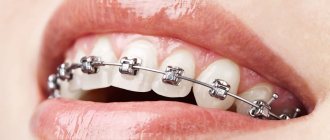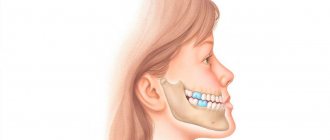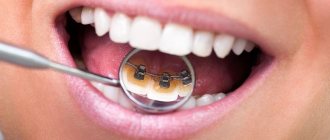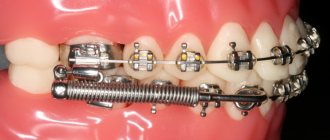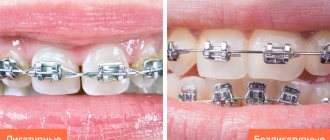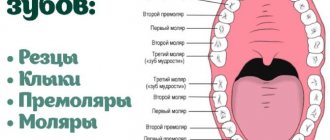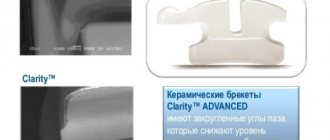Reading time 7-8 minutes
Author of the article: Tsurkan Victoria Olegovna
Specialization: Dentist-orthodontist
Total work experience: since 2015
- Stages of defect correction and expected results
- How long should you wear traction braces?
- Brief summary
When deciding on the use of orthodontic structures, patients are often interested in how long they wear braces on their teeth. Since the timing is determined individually, it is important to answer the question of what affects the duration of wear and what results to expect during the treatment process and after its completion.
Bite correction: how long does it take?
Already at the beginning of treatment, the orthodontist will tell you how long you need to wear braces - the real and maximum period of correction. The average is 1.5-2.5 years. Treatment time depends on a number of factors:
- Age of the patient - for accelerated correction, braces are placed immediately after the appearance of the main teeth of the permanent dentition.
- Bite pathology - the difficulty of correcting anomalies in the dentofacial rows directly affects the duration of treatment.
- The type and material of the orthodontic apparatus - treatment takes place differently on lingual and vestibular braces, on bracket systems made of medical sapphires, ceramics, and metal.
The principle of bite correction using a brace system
The classic system consists of directly braces (clasps), a power arch and ligatures. The clasps are fixed to the front surface of the teeth using an adhesive base. An arc is passed through them and secured with ligatures. In non-ligature designs, the arc clamps are already present on the clasps themselves.
The arch is the main element that ensures the movement of teeth. It is first given the “correct” shape, to which, thanks to the properties of the material, it tends to return. This ensures constant pressure on the teeth. As the periodontal ligaments and bone tissue gradually adapt to this traction, they become in the desired position.
Braces: wearing time depending on pathologies
How long to wear braces depends directly on your bite. Orthodontists use a special classification according to Engel, where anomalies of the dentofacial rows are divided into three groups.
The first class includes minor defects. Wearing braces can restore the correct bite in 6-12 months for pathologies:
- medium-sized diastema - a gap between the front teeth;
- crowding of the front incisors - there is not enough space for the permanent teeth due to the insufficient size of the dental arch;
- trema – interdental spaces remaining after a complete change of bite;
- transposition, dystopia - tooth eruption in the wrong place.
Rodikova Tatyana
Serious bite corrections require not only correction of the position of individual teeth, but also the formation of jaw arches. That is why the process is lengthy and requires the use of rigid orthodontic arches, elastics, and numerous techniques.
Correction of a bite with the listed anomalies is quick, especially at a young age and with the correct selection of a brace system. If we compare how long a 13-year-old child needs to wear braces and an almost adult 18-year-old patient, then the speed of treatment in the first case will be higher.
Long-term wearing of braces will require pathologies belonging to the second and third classes. Among them are the types of bite:
- distal – the lower jaw is underdeveloped, and the upper jaw is too large;
- mesial – there is underdevelopment of the upper jaw with a lack of size of the lower jaw;
- open - some of the teeth do not close, which increases the load on the rest;
- deep – the lower teeth are hidden under the upper ones, completely covered by them;
- cross - the incisors cross when the upper and lower jaws meet.
Correcting the listed problems is more difficult, so wearing braces requires two to three years, followed by consolidation of the result for another 4-5 years.
Stages of defect correction and expected results
Treatment with orthodontic structures can be divided into four main stages, each of which has its own time periods:
- Leveling
. It is the first stage and lasts 4-8 months. During this period, visually noticeable changes occur - the teeth in the row become straighter. - Mechanical movement
. The longest and, at the same time, the most important of all stages of treatment takes 6-18 months. Installing more rigid arches provokes the movement of teeth forward, backward and along the axis, and also creates conditions for correcting the bite. Visually, the changes may not be noticeable as a functional transformation occurs. - Detailing
. In terms of treatment, this is the final stage, which takes 2-6 months. By this time, all movements of the teeth and jaws have been completed and all that is required is sealing the contacts between the units and detailing their position. - Consolidation of results
. The retention period is usually twice as long as the time the braces were worn. In order to consolidate the results, removable and non-removable retailers can be used.
In some particularly difficult cases, the retention period can be lifelong, that is, retailers are appointed forever. You will be able to understand how much time it will take for you to consolidate the results during the treatment process, based on data about how flexible your teeth are to shifting.
How long do you wear braces made from different materials on average?
Initial appointments with an orthodontist are devoted to many questions: how long should a teenager wear braces and how to care for them, which system to choose and which material is preferable. At this stage, doctors immediately clarify the dependence of the duration of treatment on the material and type of bracket system:
- Metal braces. The main advantage of the metal structure is the creation of optimal pressure on the teeth. This feature guarantees the correction of even the most severe malocclusions. The average time for bite correction is 12-18 months.
- Plastic braces. They have minimal strength and the lowest cost. The duration of treatment is significant, but since the design is used to eliminate minor anomalies, patients wear polymer braces for 1-1.5 years.
- Ceramic braces. The system consists of ceramic plates in the color of enamel and a metal arc. The design is aesthetically pleasing, but fragile and does not provide the necessary pressure on pathologically located units. Not suitable for correcting serious defects. The period of wearing ceramic braces is up to 3 years.
- Sapphire braces. They have an aesthetic design, are unnoticeable, and functional. They eliminate not the most complex bite defects. The course of treatment is up to 3 years.
- Lingual braces. The design involves fixation on the inside of the teeth, which allows the use of metal without compromising aesthetics. Effective, discreet - suitable for children and adult patients. The correction period is moderate - up to 2.5 years.
Rodikova Tatyana
Teenage patients pay increased attention to aesthetics, which is why they choose ceramic braces. Metal ones are also popular, especially due to the ability to put colored rubber bands and thus express oneself.
Comparison of brace systems by duration of wearing
It is difficult to estimate the duration of wearing braces in absolute numbers. Doctors recommend systems taking into account the patient’s age and the complexity of the pathology - they select designs with a moderate duration of wear. But if you choose similar solutions to eliminate the same defect, where the duration of the correction will be shorter:
- Material. Metal is the preferred option and guarantees quick correction. In second place are ceramics, then sapphire braces and plastic ones.
- Place of fixation. Lingual braces are more effective than vestibular braces, but the latter are more comfortable to wear and more affordable.
- Ligature or self-ligating - from vestibular brace systems. Elastic ligatures help set the vector of maximum impact and provide the best point pressure on a tooth or a specific area. This strategy shortens treatment.
WEARING TIMES ASSOCIATED WITH THE SELECTED DESIGN MODEL
Many patients choose brace systems that will be less noticeable on the teeth, and not everyone takes into account the fact that the period of correction of the pathology greatly depends on the design model. To better understand what we are talking about, let's try to compare the characteristics of all existing models.
| Construction type | Positive sides | Negative sides | Terms of wearing |
| Lingual braces | Installation occurs on the inside of the tooth. This allows the structure to be invisible to others. They have good durability. | High price. Installation is not possible with short front teeth. | One and a half to two and a half years. |
| Plastic braces | Variety of colors. Low cost. | Can be colored with food coloring. They are fragile. | A year - two and a half. |
| Metal braces | Good strength. Low price. | Very noticeable to others. May rub and irritate the oral mucosa. | A year - a year of confession. |
| Sapphire braces | The transparency of the material used allows the design to be less noticeable. They do not stain and do not injure the mucous membrane. | High price. Special care. Fragility of the material. | 1–3 years |
| Ceramic braces | Good strength. Invisible due to the ability to match the natural color of tooth enamel. Safe for health (does not cause allergic reactions). | High price. Can be colored with food coloring. Due to the large volume, problems with diction may occur. Unable to correct serious violations. | 1–3 years |
How long do teenagers wear braces?
The standard age for installing braces is 12-17 years. The physiology of the child’s body makes the speed of bite correction faster and the treatment more effective. The following factors contribute to reducing the period of wearing braces:
- complete change of bite;
- eruption of second molars;
- the end of the formation of the dental system and the muscular-ligamentous apparatus while maintaining their good mobility.
The bone tissue of adolescents is plastic and quickly responds to mechanical pressure, which allows teeth to be shifted to an anatomically correct position.
Soldatenkova Alina
I am often asked how long to wear braces for a 13-year-old teenager. The average time for bite correction is 1-1.5 years. But each case is individual.
Duration of treatment with braces in children
Correcting a bite in childhood is much easier, since the bone structures have not yet fully formed and can be easily corrected. The sooner treatment begins, the less time it will take to make your smile perfect. If before braces the child wore other orthodontic structures (plate, trainer), then the treatment time can be reduced by almost half. On average, the treatment period for children is 8 months less than for adults. Therefore, the answer to the question “at what age is it best to install braces” will be 12 – 14 years.
Wearing braces: average time, minimum, maximum
Children's orthodontists have long collected statistics on how long it takes from fixation to removal of braces:
- quick treatment – six months to a year;
- the average for severe anomalies is 1-2.5 years;
- the maximum period (registered record) is more than 9 years.
Every year the complexity and duration of treatment increases. Correcting the same pathology at 27 years old will require almost a year more time than at 18 years old.
Direct installation of braces
Although the common expression is “getting your braces on,” they are technically bonded using a special solution. There are two fixation methods:
- Direct bonding involves attaching braces to each tooth separately. First, it is thoroughly dried, treated with a composition to give a slight roughness and dried again, and only then braces are placed. This is a painstaking procedure that requires high professionalism from the orthodontist.
- Indirect bonding involves bonding braces at the same time. The doctor attaches them to a cast of the jaw in advance, and then simply “transfers” them to the teeth, using special trays for this. Of course, this method takes much less time. The indirect bonding method is used in orthodontics more often than direct bonding.
The procedure itself is completely painless, but requires great perseverance from the patient. He will have to sit motionless throughout the entire process with his mouth open while the doctor performs the necessary manipulations.
How to speed up treatment with braces
All patients can delay the time of braces removal. To do this, you must comply with the requirements of the pediatric orthodontist:
- Come to scheduled appointments. An appointment is more than just an examination. When communicating with the patient, the doctor evaluates the dynamics, changes ligatures and arches, and selects elastics for enhanced correction.
- Monitor the integrity of the system. If the ligatures break, the bracket comes off, or the orthodontic arch falls out, the patient needs to urgently consult a doctor to restore the structure.
- Change elastics according to schedule. At a certain stage of correction, the orthodontist strengthens the work of braces with the help of elastic bands. At home, the patient must change elastics every 12 hours - independently and without skipping.
Wearing braces is an effective way to correct the position of teeth and bite characteristics. Following the orthodontist's recommendations will help you get rid of crooked teeth, protruding or receding jaws - make your teeth straight and beautiful.
Oral preparation
The very first step before installing braces is a professional consultation with an orthodontist. The specialist examines the oral cavity, evaluates the teeth and gums. After this, he directs the patient to a panoramic photograph of the jaw. Having it in hand, the doctor receives a complete clinical picture and draws conclusions regarding the installation of orthodontic structures - whether it is advisable to prescribe the procedure in a particular case.
Braces are installed only on absolutely healthy teeth. Therefore, if the doctor identifies dental problems in the patient, they must first be eliminated. Treatment of caries may be necessary, including filling, and some other manipulations. Professional hygienic cleaning of the oral cavity is also required to remove plaque and tartar. Teeth must be clean and healthy before installing braces. Only after successful completion of the therapeutic process can the doctor prescribe the procedure.
It is important to change the arc on time
At each stage of treatment you need to get a certain result. Once it is reached and the teeth have assumed their new position, the archwire no longer works. And if you often postpone doctor's appointments, each week of delay prolongs the entire treatment.
Wearing one archwire for too long does not harm your teeth, but it does not make sense.
Treatment by an orthodontist requires self-discipline. Be prepared to adjust your schedule around your doctor's appointments. And remember that all this is done for the sake of health and a beautiful smile. And this is the best incentive!
What factors affect wearing time?
- 1. Age. Bone tissue and ligaments in adolescents are more plastic, so eliminating bite problems of any complexity before the age of 18 requires an average of 3-6 months less time. This does not mean that complex defects cannot be corrected for an adult, but more time will have to be spent.
- 2. Complexity of the defect. The severity of the anomaly and its type also affect the timing of treatment. Even the most advanced cases of crowding are corrected faster than problems with jaw closure.
- 3. Type of system. The material and design of braces affect the timing. Non-ligature metal structures are the fastest to correct. Lingual ones take the longest, but they are invisible.
- 4. Doctor's experience. Optimal selection of the system, correct installation, control of tooth displacement - parameters that depend on the experience of the orthodontist. In our clinic, doctors are constantly improving their skills, so they can correct your bite in a minimum amount of time.
- 5. Patient compliance with recommendations. Following a diet and proper care of systems are also important. Damage to structures and the development of caries can cause a suspension of correction or a decrease in the effectiveness of treatment.
What to do if the bracket comes off?
In itself, this happens quite rarely, only in cases of severe crowding of teeth, since the arch puts a lot of pressure on the dentition and the lock falls off. Another option is if the patient is a nut or other solid food lover.
If you find a broken bracket, contact your orthodontist immediately. Otherwise, the teeth will begin to gradually move to their original position. Also remove elastic bands if you wear them.
The doctor sees patients with unstuck braces out of turn. It takes about 5 minutes to glue a new lock.
It also happens that the archwire flies out of the bracket grooves. You can try to get it back yourself. However, this should be done extremely carefully, without damaging the adjacent locks.
Braces care
You should pay close attention to your oral hygiene while wearing braces to avoid the risk of tooth decay or other complications. To care for your teeth and braces, use special devices: brushes, brushes, and irrigators to effectively remove pieces of food between the structural elements. Floss (special thread) is good for removing food debris between teeth. When using braces, you should also exclude from your diet some foods that have increased coloring properties. This way you will protect the elements from more frequent replacement. For example, ceramic braces have an increased tendency to pigmentation.
Retention period
This period is mandatory when treating with braces.
The main correction with braces contributes to the emergence of a new shape of the tooth bed, and the retention stage allows the muscular and ligamentous apparatus that holds the crown in the desired position to be strengthened.
Retainers, special mouthguards and trainers are used as fastening devices. Depending on the device used, the retention period may vary significantly.
How long should you wear aligners after braces are removed?
Mouthguards are a special removable design that is worn only for a while and can be easily removed for cleaning the crowns or eating . The mouthguards are made of elastic hypoallergenic polymer, so they are practically not felt on the teeth.
Practice shows that in order to obtain a high-quality result, the mouthguard must be worn for the same period of time that was spent on the main treatment .
But at the same time, depending on the severity of the orthodontic abnormality and the age category of the patient, the retention period may be slightly reduced.
During the first months, mouthguards must be worn up to 22 hours a day, then this time decreases.
Duration of wearing retainers
This device differs from others in the duration of use. As a rule, it is calculated according to the following scheme: the time for correcting a bite with braces is doubled . The period of wearing retainers should be determined and adjusted only by a dentist.
The duration of this stage is a disadvantage of this system, but at the same time it has a huge advantage - the uniqueness of the design. A retainer is a small arch installed on the inside of the crowns, which does not cause discomfort and is not felt or noticeable on the teeth at all .
Discomfort after activating braces
It often happens that after replacing the archwire or rubber ligatures, unpleasant, even painful sensations occur. This is normal. According to patient reviews, such discomfort is observed after the first corrective interventions. With each new activation, the inconvenience is noticeably reduced, and over time the procedure becomes familiar. After it there is only a feeling of slight tightness, which quickly passes.
Doctors advise: if, after activating the system, you feel that the arc is pressing on your cheeks or lips, you should not endure it, but go to the clinic for correction. The orthodontist will check the integrity of the system and remove the excess part of the arch.
In case of individual increased sensitivity of teeth, you can take non-steroidal anti-inflammatory drugs for the first two days after activation to reduce pain. Your doctor will tell you in detail what medications to use in this case.
Second month of treatment: correction of gross anomalies
The first changes become noticeable in the photo by the end of the second month. The orthodontic arch, after installation, repeated the shape of the abnormal bite, over time began to return to the originally specified state, corresponding to the correct bite. At the same time, under the force of her traction, the teeth also began to move in the right direction.
The first positive results are so impressive that some patients are ready to remove their braces at this stage. Of course, this is impossible. Orthodontic treatment initiates the natural biomechanical process of bone removal and growth, interrupting which will force the teeth to return to their original position.
What can increase treatment time?
When installing braces, the dentist determines only the approximate duration of treatment, which may differ significantly in the outcome. At the same time, this period does not decrease, but only increases.
This may be due to several reasons:
- Poor oral hygiene leading to periodontal disease.
In some cases, inflammation of the gum tissue leads to loosening of the crowns, so the system must be completely removed. While periodontal treatment is being carried out, the teeth can take their primary position and the correction time increases almost 2 times. - Design of the system used .
Depending on the braces model, the treatment time can be increased by a noticeable period. Often it is 4–6 months. The essence of the problem is that the parts of some models are more fragile than the metal structure. Their failure leads to the need for replacement. In most cases, in order to install a new element, you need to wait until it is available in the clinic. During this time, the crown does not undergo the necessary treatment and, at best, is not corrected, and at worst, it returns to its previous position. - Orthodontic arch. The force of pressure on the crowns depends on the material used to make the arch. The tougher the element, the faster the treatment will take place.
Is it possible to speed up the treatment period?
Now you can find many dentists where they promise to provide treatment with braces in the shortest possible time, which do not meet the standards of the system . Unfortunately, such statements are just a publicity stunt.
It has long been proven in medicine that the position of crowns can be corrected only within the time limits specified for the system used . This period can be extended, but not shortened.
The tooth has a formed bed of bone tissue. Changing bone requires daily, small, focused effort. Rapid formation of another bed is possible only with the help of surgical intervention.

